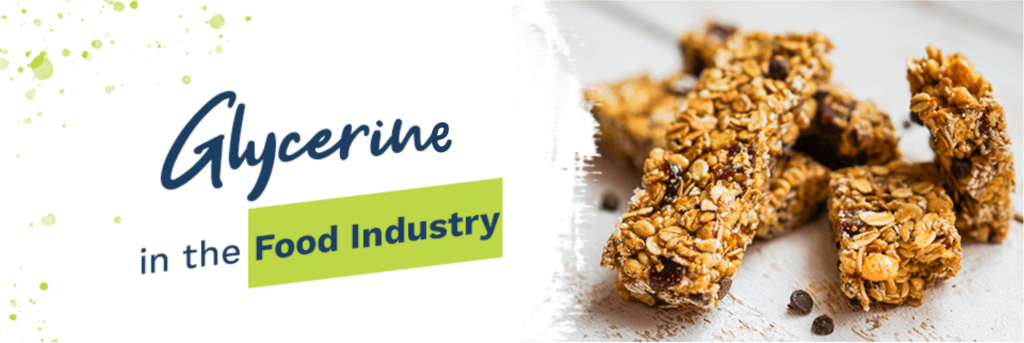Glycerine in the Food Industry

Jump to:
- What is Glycerine?
- Glycerine Uses and Benefits
- Is Glycerine in Food Safe to Eat?
- Potential Issues With Glycerine Overconsumption
- Is Glycerine Vegan?
- Which Foods May Contain Glycerine?
- Contact Acme-Hardesty to Learn More
These days, the foods we consume contain a wide range of additives. These “extra” ingredients can serve many purposes, such as enhancing flavor, improving a food product’s appearance to make it more appealing to consumers and preserving the items to reduce the risk of spoilage.
If you glance at the label on many food items, you may observe a listing for an ingredient called glycerine. In this post, you’ll learn more about what glycerine is, whether it’s safe to eat and the foods and beverages that may contain it.
What is Glycerine and its Various Forms?
Glycerine, or glycerol, is a colorless, odorless viscous liquid commonly used in food and cosmetics. Its forms include U.S. Pharmacopeia (USP), Chemically pure (CP), High-gravity, Dynamite, and Saponification crude and soap lye. While the terms “glycerine” and “glycerin” are often used interchangeably, the latter typically refers to a purified version containing 95% or more of glycerol. Glycerine is 60% to 75% as sweet as sugar. It’s also more calorie-dense than other sugar alcohols and contains more calories than sugar (4.32 vs. 3.87 calories per gram).
The various forms of commercially available glycerine include:
- U.S. Pharmacopeia (USP): This high-purity glycerine version exhibits odor and taste characteristics suitable for pharmaceutical and food use. It features an anhydrous glycerol level of 96%, 99% and 99.5%, although products with a higher concentration are also commercially available.
- Chemically pure (CP): This glycerine version is generally the same grade and quality as USP. The difference is that CP is classified as generic in the U.S. because it doesn’t indicate compliance with official quality specifications.
- High-gravity: The U.S. uses this commercial-grade glycerine designation for products complying with Federal Specification 0-G-491C. It must contain a glycerol concentration of no less than 98.7%, although a 99% level is common.
- Dynamite: This material meets all the grade specifications for high-quality glycerine, except for color. It cannot be darker than the guidelines stipulated in the U.S. Federal Color Standard.
- Saponification crude and soap lye: These terms refer generically to products that don’t meet the 95% glycerol concentration threshold. The use of these compounds is typically relegated to refining applications rather than anything involving human consumption.
The Uses and Benefits of Glycerine
Glycerine is a versatile ingredient that can offer numerous benefits for users:
- Helps the healing process: Glycerine promotes the natural maturation of skin cells, enabling this compound to serve as an inexpensive solution for healing wounds, blemishes and scratches.
- Aids digestion: Laxative capsules containing a glycerine ingredient can stimulate bowel movements, providing relief to people suffering from chronic constipation.
- Prevents dry skin: Individuals who experience prolonged exposure to sun and wind may lose some of the moisture content in their skin. Applying a body lotion or oil containing glycerine can prevent the skin from drying out.
- Slows aging: Glycerine’s moisturizing properties can also help maintain skin elasticity and minimize the appearance of wrinkles. Users can look younger and develop fewer unattractive blemishes.
- Treats cerebral edema: Cerebral edema is a potentially serious medical condition in which fluid builds on the brain, potentially resulting in strokes, meningitis or tumors. Intravenous glycerine injections can help relieve this pressure.
Is Glycerine in Food Safe to Eat?

Glycerine is a safe additive in many of the food and beverage products we consume. While glycerine forms naturally via the alcoholic fermentation of sugars, it mostly comes from the production of the hydrolysis of fats and oils and the fermentation of yeast, oils and starches. When serving as a food ingredient, glycerine can help to retain moisture content, reduce or prevent sugar crystallization and enhance bulk, texture, sweetness, smoothness and softness.
Food-grade glycerine in the United States must meet the requirements found in the Food Chemicals Codex developed by the Committee on Food Protection of the National Research Council. These guidelines are similar to the USP standards.
Although glycerine is not an essential component in a human’s diet, it does not pose a health threat, even when consumed in high quantities. The small intestine readily absorbs the ingredient and digestion will occur without complications. Additionally, glycerine does not promote insulin secretion. Consequently, it can help maintain lower glucose levels than other carbohydrates.
The following nations and organizations have deemed glycerine safe for human consumption:
- European Union
- Australia
- Japan
- Canada
- World Health Organization
- U.S. Food and Drug Administration
Potential Issues with Glycerine Overconsumption
While glycerine in food is safe, ingesting large amounts at once can cause side effects. Individuals may experience diarrhea, bloating, excessive thirst, nausea or hyperglycemia. However, most foods and beverages consumed by humans don’t contain sufficient glycerine levels to cause these effects. Since glycerine is not detrimental to human health, the FDA or other health organizations have not established an acceptable daily intake level for the substance.
Is Glycerine Vegan?
Although most of the glycerine used as a food ingredient comes from animal fats, there’s also a product known as vegetable glycerine. While some vegans prefer to avoid vegetable fats, others accept ingredients like vegetable glycerine in the products they consume. You can find vegetable glycerine in various items produced by the food, pharmaceutical and cosmetics industries.
Vegetable glycerine comes from heating triglyceride-rich vegetable fats like coconut, soy and palm oils under intense pressure. This process causes the glycerine to break away from the fatty acids and combine with water to form a syrupy, sweet-tasting liquid.
Veganism, which is the practice of abstaining from consuming animal products, is on the rise in many parts of the world. While there are no specific totals, some surveys indicate that there were approximately 1.5 million vegans around the globe as of 2020.
Which Foods May Contain Glycerine?
Glycerine’s value as a sweetener, preservative, moisture retainer and thickening agent, along with its other attributes, make it a versatile ingredient in food products such as:
- Dried fruits and vegetables.
- Soups.
- Energy bars.
- Spices.
- Soft candies.
- Condiments.
- Marshmallows.
- Cake icings.
- Chewing gum.
- Ice cream.
- Various packaged and canned foods.
- Extracts and flavorings.
Beverages and other liquid products that often contain glycerine include beer, wine, honey and vinegar.
Contact Acme-Hardesty to Learn More

Do you have questions about the use and safety of glycerine in the food industry? Acme-Hardesty has the answers. As a leading supplier of renewable palm-based glycerine, fatty acids, fatty alcohols and other high-quality bio-based ingredient solutions for the personal care industry, we can provide the information you need to make an informed purchasing decision for your company. We serve the needs of the food, pharmaceutical and nutraceutical industries and many others.
Call us at 800-223-7054 or contact us online today for more information. We can also provide a free, no-obligation quote for larger orders.
